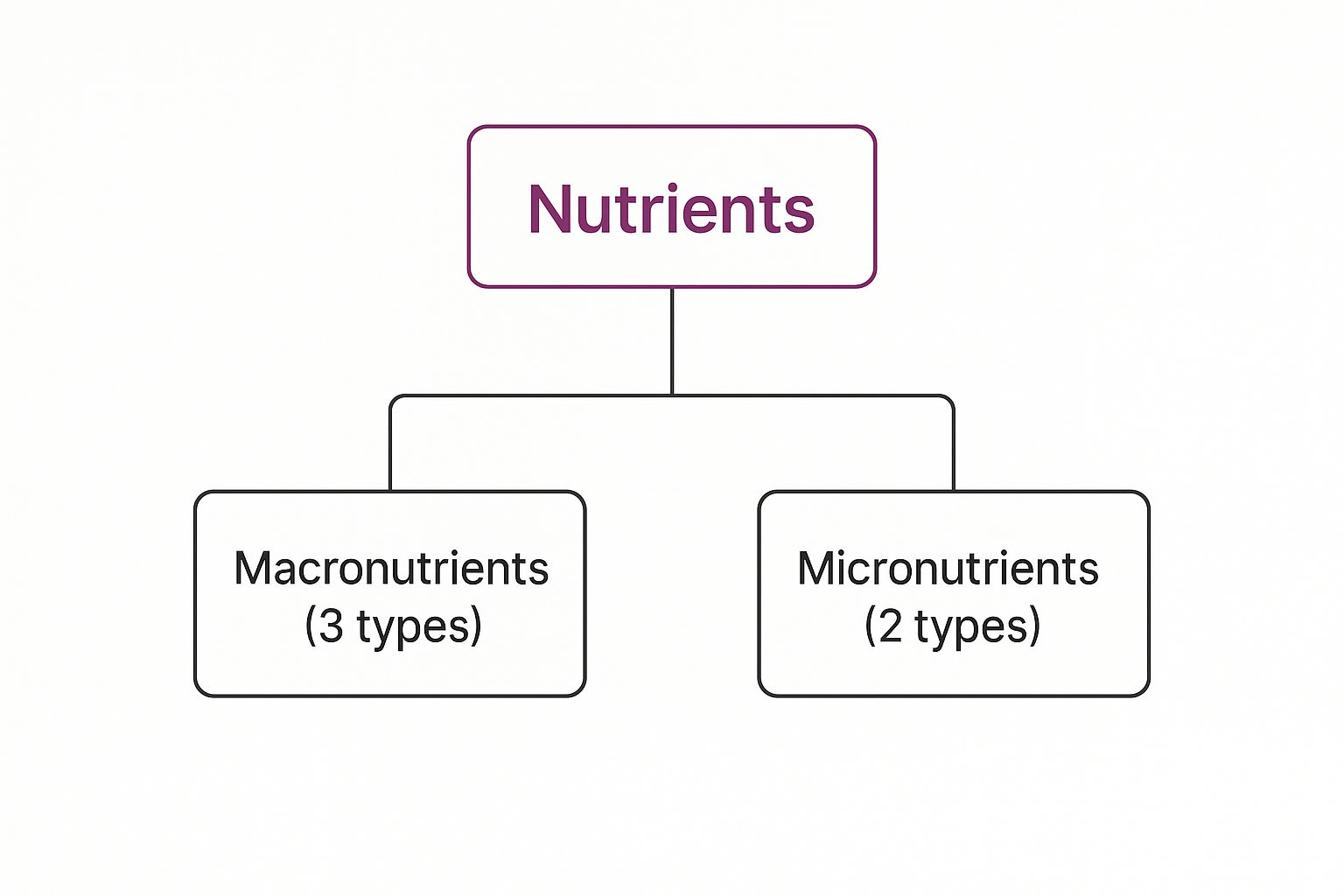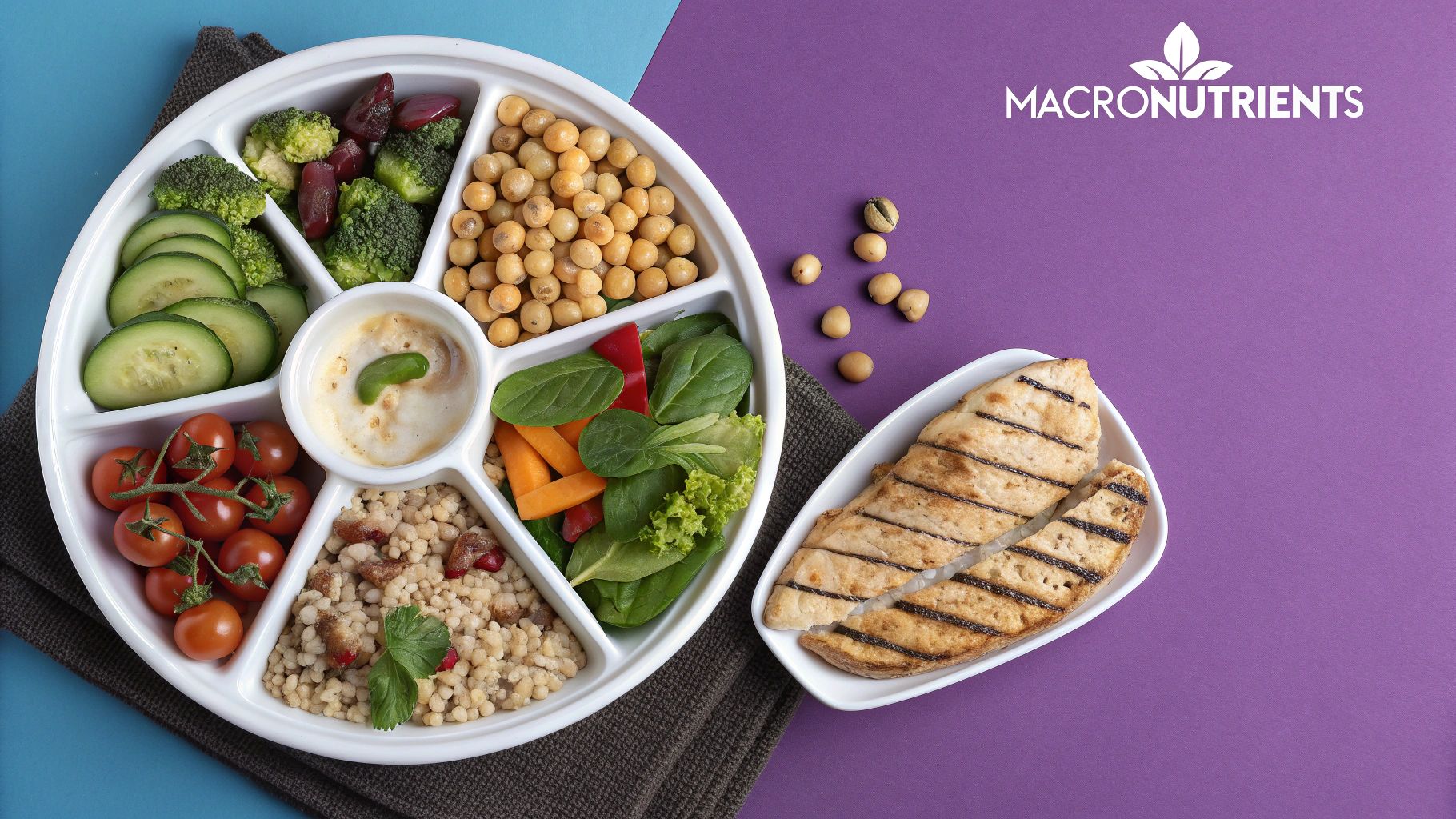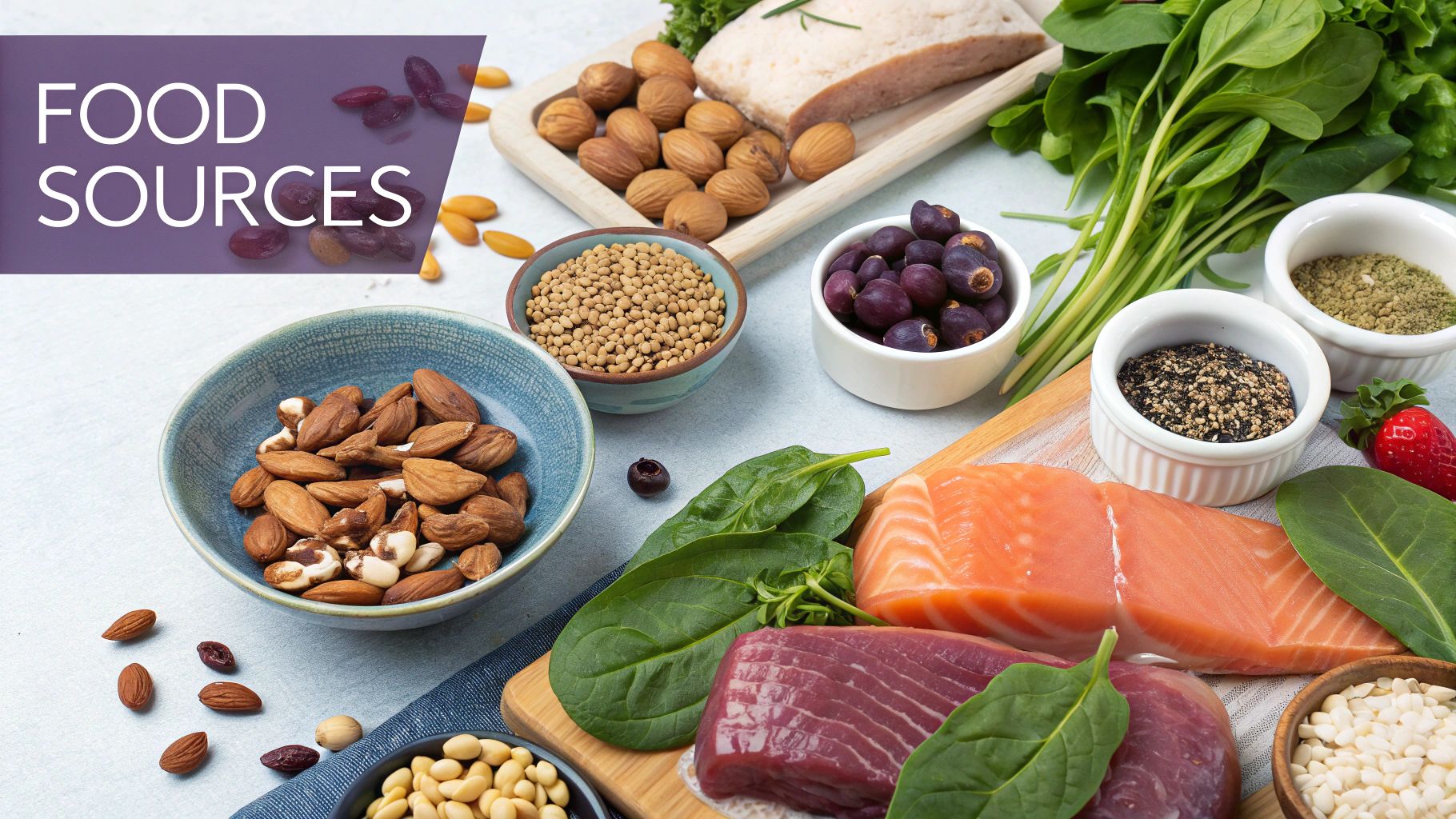
What Are Macronutrients and Micronutrients? A Complete Guide
Let's get back to basics with nutrition. It's easy to get lost in the details, but it all comes down to two simple categories. Think of your body like a construction project.
The big, heavy-lifting materials—the bricks, steel, and concrete—are your macronutrients.
Then you have all the smaller, but equally crucial, components. Things like the wiring, plumbing fixtures, and nails. These are your micronutrients. Without them, the whole structure just doesn't work.
Your Nutritional Building Blocks
Everything you eat is made up of these two types of nutrients. Macronutrients—which are proteins, carbohydrates, and fats—are the ones you need in large amounts. We measure them in grams because they're the primary source of your body's energy and the raw materials for growth and repair.
Micronutrients, on the other hand, are the vitamins and minerals. Your body only needs them in tiny quantities (think milligrams or even micrograms), but their impact is massive. They're the spark plugs that kick off thousands of essential chemical reactions.
This simple breakdown shows how all nutrients fit into these two core groups.

Getting a handle on this "macro" vs. "micro" concept is really the first step to eating smarter. You can't build a healthy diet without understanding your core materials.
For a quick summary of the key differences, this table lays it all out.
Macronutrients vs Micronutrients at a Glance
| Nutrient Type | Primary Role | Required Amount | Examples |
|---|---|---|---|
| Macronutrients | Provide energy (calories), build and repair tissue | Large amounts (grams) | Proteins, Carbohydrates, Fats |
| Micronutrients | Support metabolic processes, immune function, and cellular health | Small amounts (milligrams/micrograms) | Vitamin C, Iron, Calcium, Vitamin D |
Seeing them side-by-side really clarifies how they work together to keep you going strong.
If you want a creative way to stay on top of your nutrition, making a visual plan can be a huge help. Tools like our Meal Planner Coloring Book can turn the chore of meal prep into something fun, making it easier to ensure you’re getting a healthy balance of both your macros and micros every single day.
Macronutrients: Fuel for Your Body and Goals
Think of macronutrients as the major fuel sources your body runs on. They're the nutrients you need in large quantities every single day to provide energy, build and repair tissue, and just keep everything running smoothly.
Getting a handle on the big three—proteins, carbohydrates, and fats—is the first real step to designing a diet that actually helps you hit your fitness goals.

Proteins: The Body's Building Blocks
First up, we have proteins. These are the construction crew for your body. They are absolutely essential for repairing tissues, growing muscle, and even keeping your immune system strong.
Every time you work out, you're creating tiny tears in your muscle fibers. Protein provides the raw materials—amino acids—to patch up those tears, making the muscle stronger than it was before. For anyone serious about their training, a good protein powder can make a huge difference in hitting those daily protein targets efficiently.
Carbohydrates: The Preferred Energy Source
Next are carbohydrates, which are your body's go-to source for quick, accessible energy. Carbs get broken down into glucose, the primary fuel that powers your cells, muscles, and brain.
It’s smart to know the difference between simple carbs (like sugar) for a fast energy jolt and complex carbs (found in whole grains and veggies) for slow-burning, sustained fuel that lasts.
Fats: More Friend Than Foe
Finally, let's clear the air about fats. Healthy fats are far from being the enemy; they’re vital for producing hormones, maintaining brain health, and absorbing certain vitamins.
Foods like avocados, nuts, and olive oil pack a punch of concentrated energy and support your overall well-being.
Building Your Ideal Plate
The real magic happens when you get the balance of these three macronutrients right. Your perfect ratio isn't a one-size-fits-all formula; it depends entirely on what you're trying to achieve.
- Strength Training: A higher protein intake is non-negotiable for muscle repair and growth.
- Endurance Sports: Carbohydrates take center stage to provide the sustained energy needed for those long sessions.
- General Wellness: A balanced plate with moderate amounts of all three is usually the best approach for supporting daily life.
It's interesting to see how global nutrition has evolved. Between 1980 and 2013, energy from proteins and fats went up in most countries, while carb intake trended down. This shift is significant, especially when you consider that over 1 billion people worldwide still face protein deficiency.
For any athlete trying to get the most out of their body, a solid meal plan is everything. If you need some ideas, you can dive into our healthy diet plan for athletes to get started.
Micronutrients: The Unsung Heroes of Your Health
If macronutrients are the fuel that powers your body, micronutrients are the intricate machinery that makes it all run. You only need them in tiny amounts, but without them, your body can't unlock the energy from your food, keep your immune system sharp, or manage the countless processes happening every second.

Think of them as the tiny but powerful managers working behind the scenes. Without a steady supply of these vitamins and minerals, your body simply can't perform at its peak.
They truly are the unsung heroes of good health.
What Are Vitamins and Minerals?
Micronutrients fall into two main camps: vitamins and minerals. Vitamins are organic compounds your body needs to kickstart thousands of chemical reactions, while minerals are inorganic elements that build our bodies and keep everything in balance.
You can break them down even further:
- Fat-Soluble Vitamins: This group includes vitamins A, D, E, and K. Your body is smart and stores these in your fatty tissues and liver, so you don’t need to top them up every single day.
- Water-Soluble Vitamins: This bunch includes Vitamin C and all the B vitamins. Unlike their fat-soluble cousins, your body can't store these, so you need to get them from your diet regularly.
Minerals are also grouped by how much we need. We require larger amounts of "major" minerals like calcium for strong bones, but "trace" minerals like iron and zinc are just as vital, even though we need less.
It's all connected. You need Vitamin D to properly absorb calcium, and you need iron to make red blood cells that carry oxygen and keep you energized.
"Hidden hunger" is a real and serious issue affecting people all over the world. It’s a state where someone gets enough calories to feel full but is starved of the essential micronutrients their body needs to truly thrive.
This phenomenon shows why the quality of our food is just as important as the quantity. It's staggering to think that more than half the world's population isn't getting enough key micronutrients. In fact, iron deficiency alone impacts over 4 billion people. You can read more about the global impact of micronutrient deficiencies on hsph.harvard.edu.
To help fill in any nutritional gaps you might have, a well-formulated supplement can be a great safety net. Our Multivitamin & Mineral Support is specifically designed to provide a comprehensive spectrum of these vital nutrients, making sure you’ve got all your bases covered.
Balancing Your Plate for Optimal Performance
Knowing the difference between macronutrients and micronutrients is a great start, but the real magic happens when you apply that knowledge to your actual meals.
The good news? You don't need a degree in nutrition or a complicated spreadsheet to get it right.
A brilliantly simple tool is the 'plate method.' It’s all about visual cues.

Just picture your plate: fill half of it with colorful, micronutrient-rich vegetables. Dedicate one-quarter to a solid source of lean protein, and the final quarter to some quality complex carbs.
This simple visual trick helps you build a balanced meal every time, no calorie-counting required.
Tailoring Your Plate to Your Goals
Of course, one size doesn't fit all. The ideal balance on your plate will shift depending on what you're trying to achieve. Think of it as tuning your fuel mix to match your body's specific demands.
An endurance runner, for instance, is going to need more carbs to power through those long miles. Someone focused on building strength in the gym? They'll want to bump up the protein to help repair and grow muscle.
- For Muscle Growth: Make that protein section a little bigger. Your muscles will thank you for the extra building blocks.
- For Endurance: Add some more complex carbs. This is your long-lasting energy source.
- For General Health: Stick with the classic plate method. It's a fantastic, sustainable foundation for everyday wellness.
Learning to make these small tweaks is incredibly empowering. It turns eating from a set of rigid rules into a flexible system that truly works for you.
The best eating plan isn't about what you cut out. It's about building a balanced plate that fuels your specific goals, keeps your energy steady, and makes you feel great.
A key skill in all of this is being able to decipher what's actually in your food. To get confident with that, check out our guide on how to read nutrition labels. It’s a game-changer for making smarter choices at the grocery store and connecting what you buy with your macro and micro targets.
Why Nutrient Imbalances Are a Global Challenge
It's one thing to understand the macronutrients and micronutrients on your own plate, but that knowledge also opens a window into a much bigger, more complex global issue.
For millions of people, access to genuinely nutritious food isn't guaranteed; it's a daily struggle deeply tied to where they live and their economic situation.
Think about it: many modern diets, especially those packed with processed foods, deliver plenty of calories. You get your fill of carbs, fats, and proteins. But what's often missing are the essential vitamins and minerals your body is crying out for. This leads to a widespread and dangerous problem called 'hidden hunger.'
The Hidden Hunger Crisis
This is a strange paradox, isn't it? Someone can be getting more than enough calories, even to the point of being overweight, yet be completely undernourished.
They might feel full, but on a cellular level, their body is starved of the critical tools it needs to run properly—to build a strong immune system, produce energy, and maintain long-term health.
The link between poverty and poor nutrition is undeniable. Over half of children under five across the globe suffer from deficiencies in crucial nutrients like iron, zinc, or vitamin A.
In many developing regions, diets are built around a few staple crops that can fill a stomach but offer very little in the way of micronutrient diversity. The health consequences can be devastating. For a deeper look at the data, you can explore the issue of global micronutrient deficiency on Our World in Data.
Bringing it back to your own health, a great first step to bridging any nutritional gaps is to simply pay attention. Our Meal Planner Coloring Book offers a creative and engaging way to track what you eat, helping you see where you're at and make smarter choices for a better nutrient balance.
Your Nutrition Questions Answered
Diving into the world of nutrition can feel like opening a can of worms—the more you learn about what macronutrients and micronutrients are, the more questions pop up.
It's one thing to know the definitions, but it's another to figure out how it all works in real life. Let's clear up some of the most common questions.
Do I Really Need to Track My Macros and Micros Every Single Day?
Honestly, for most of us just trying to be healthy, the answer is no. Obsessively tracking every gram isn't necessary and can feel like a full-time job.
A much better, more sustainable strategy is simply focusing on eating a variety of whole foods.
That said, if you have a very specific goal—like serious muscle gain or a big fat loss target—tracking for a little while can be a game-changer. Think of it as a short-term diagnostic tool to see where you stand, not a lifelong sentence.
Can I Get Everything I Need from Food Alone?
In a perfect world, yes. A well-planned, diverse diet built on whole foods is always the goal and should be your first line of defense.
But we don't live in a perfect world. Modern farming has led to soil that's less nutrient-rich than it used to be. Add in things like intense workout schedules or dietary restrictions (like being vegan), and nutritional gaps can easily appear.
For example, getting enough Vitamin D from food is notoriously difficult, and Vitamin B12 is primarily found in animal products. This is where our Multivitamin & Mineral Support can be a smart way to fill in the gaps and make sure your body is firing on all cylinders.
What Are the First Signs That My Nutrition Is Off?
The early warning signs of a nutrient imbalance can be sneakily subtle. If your macronutrients are out of whack, you might just feel constantly hungry, tired all the time, or notice that your progress in the gym has completely stalled.
Micronutrient shortages tend to show up in different ways. Some classic signs include:
- Brittle nails: This could be a hint that you're low on iron or biotin.
- Getting sick often: Your immune system might be crying out for more Vitamin C, D, or Zinc.
- Brain fog: Feeling fuzzy and unfocused is often linked to a lack of B vitamins.
If any of these sound familiar and just won't go away, it’s a good idea to chat with a doctor or a registered dietitian to get to the bottom of it.
Should I Worry About Total Carbs or Net Carbs?
The whole "net carbs" thing got really popular with diets like keto, but it's easy to miss the forest for the trees. A far better approach for long-term health is to focus on the quality of your carbs, not just the numbers.
Think about it: the vitamins, minerals, and fiber you get from 100 calories of a sweet potato are worlds apart from what you'd get from 100 calories of a processed, low-carb snack bar. Always choose complex carbs from whole foods—they provide steady energy and a boatload of micronutrients.
Here at Diet and Exercise, we know that understanding your body is the first step on any health journey. If you're looking for fun and creative ways to plan your meals and stay motivated, take a look at our collection of planners and wellness tools at the Diet and Exercise Shop.
